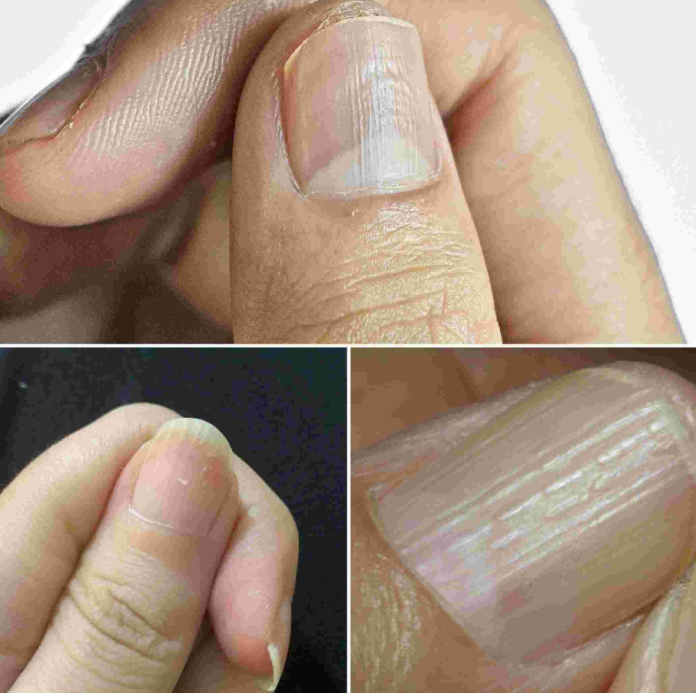Nails can reveal much about our overall health, and noticing changes such as vertical ridges can be concerning. While these ridges are often harmless and a natural part of aging, they can sometimes indicate underlying health issues or nutritional deficiencies. This article delves into the potential causes of vertical ridges on your nails, highlighting when it might be time to consult a healthcare professional.
The Natural Process of Aging
As we age, it’s common to notice vertical ridges on our nails. These ridges, running from the cuticle to the nail tip, are typically harmless and a normal part of aging. As we grow older, the body undergoes various changes, and the nails are no exception. The matrix, the part of the nail where new cells are produced, can become less efficient over time, resulting in these vertical lines.
Inadequate Nutrient Intake
Nutritional deficiencies can significantly affect nail health, leading to vertical ridges and other changes. Some essential nutrients for healthy nails include:
- Protein (Keratin): Keratin is the primary protein in nails. A lack of protein in your diet can hinder the body’s ability to produce strong, healthy nails.
- Vitamin B12: Deficiency in vitamin B12 can alter the color and texture of your nails, leading to vertical ridges and other abnormalities.
- Iron: Iron deficiency, or anemia, can cause vertical ridges and spoon-shaped nails. Iron is crucial for the production of hemoglobin, which carries oxygen to the nail matrix.
Ensuring a balanced diet with adequate protein, vitamins, and minerals is vital for maintaining nail health.
Fluid Loss
Dehydration affects every part of the body, including nails. Without sufficient water intake, nails can become brittle and develop vertical ridges. Drinking plenty of water daily helps maintain hydration levels, ensuring that your nails and skin stay healthy and robust.
Nail Trauma
Injuries to the nails can also cause vertical ridges. Trauma, such as crushing injuries or persistent nail picking, can damage the nail bed and disrupt normal nail growth. Even minor injuries can lead to noticeable changes in the nail’s appearance as it heals and grows out.
Skin Conditions
Certain skin conditions that affect the cuticles or the skin around the nails can lead to vertical ridges. Conditions like eczema or psoriasis can cause inflammation and damage to the nail matrix, resulting in ridges and other nail abnormalities.
Cardiovascular Diseases
Poor circulation and cardiovascular issues can impact nail growth and appearance. Restricted blood flow can affect the delivery of essential nutrients to the nail matrix, leading to problems such as vertical ridges. Conditions like peripheral artery disease or other cardiovascular problems can manifest in the nails, signaling underlying health issues.
Preventive Measures and When to See a Doctor
While vertical ridges on nails are often a natural part of aging and usually harmless, it’s essential to monitor any other changes. If you notice changes in nail color, thickness, or other symptoms accompanying the ridges, it might be wise to consult a healthcare professional. Here are some preventive measures to keep your nails healthy:
- Balanced Diet: Ensure your diet includes sufficient protein, vitamins, and minerals.
- Hydration: Drink plenty of water to maintain hydration levels.
- Avoid Nail Trauma: Be cautious to avoid injuries to your nails and avoid habits like nail picking.
- Manage Skin Conditions: If you have conditions like eczema or psoriasis, seek appropriate treatment to manage symptoms and reduce nail damage.
Conclusion :
Vertical ridges on nails can be a benign sign of aging or an indication of more serious health issues. Understanding the potential causes can help you determine when to seek medical advice. Maintaining a balanced diet, staying hydrated, and avoiding nail trauma are essential steps in keeping your nails healthy and strong. Remember, your nails can provide valuable insights into your overall health, so paying attention to changes can lead to early detection of potential issues.
By understanding the real causes of vertical ridges on your nails, you can take proactive steps to maintain nail health and address any underlying conditions that may be contributing to these changes.
Source of the picture : Barbara O’Neill Lectures










